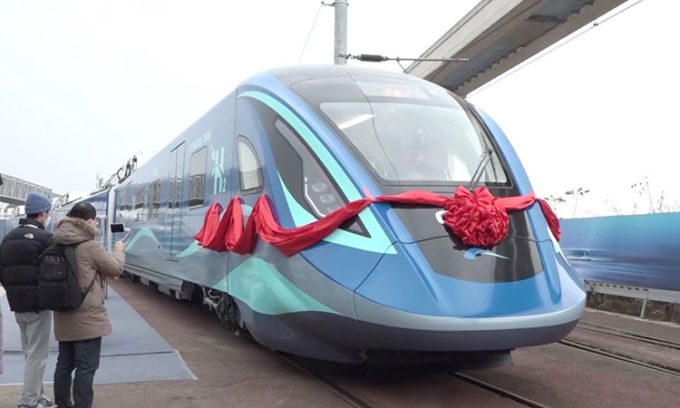The world’s first hydrogen-powered urban train rolled off the production line in Chengdu, Sichuan last week.
The vehicle, developed jointly by the Changchun Railway Company and Chengdu Railway Company, utilizes core technology from the Fuxing bullet train, with a maximum speed of 160 km/h. It is equipped with a “hydrogen energy” system, providing a strong and sustainable power source with an operational range of 600 km per refueling.

Hydrogen-powered urban train rolls off the production line in Chengdu. (Photo: CNS).
According to the Chengdu Daily, the train combines hydrogen fuel cells and supercapacitors for its power supply. The energy is generated through the electrochemical reaction of hydrogen and oxygen in the fuel cells. This reaction emits only water and no byproducts containing nitrogen or sulfur, while the process is stable and operates quietly.
Hydrogen is a clean, renewable energy source and represents an important new energy option to promote a carbon-neutral economy. A hydrogen train running 500 km daily at a speed of 160 km/h can reduce carbon dioxide emissions by more than 10,000 kg annually, experts report.
Additionally, by eliminating some constraints related to operating conditions, the train can be widely used on non-electrified routes, significantly expanding its application range while avoiding the enormous investment and maintenance costs associated with electrification efforts.
According to CNS, the hydrogen-powered urban train is also integrated with many advanced smart technologies. In terms of control, the vehicle employs the highest level of automatic driving technology, offering smart driving functions such as automatic wake-up, start, automatic stops, and automatic returns to the station.
China has ambitious plans to promote the development of the hydrogen energy sector. By 2025, the country is expected to have around 50,000 hydrogen fuel cell vehicles, with annual hydrogen production from renewable sources reaching 100,000 to 200,000 tons, according to a plan jointly released by the National Development and Reform Commission and the National Energy Administration last March.


















































